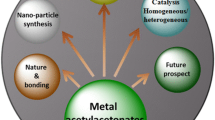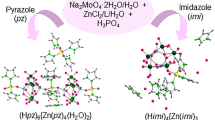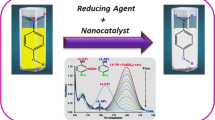Abstract
A series of organotin(IV) semicarbazone adducts of the type R2SnCl2·nLH (1–6) were synthesized by the reactions of R2SnCl2 with newly synthesized carvone semicarbazone (LH) in anhydrous ethanol [where R = CH3, n = 1 (1), 2 (2); R = C4H9, n = 1 (3), 2 (4); and R = C6H5, n = 1 (5), 2 (6)]. All the compounds have been characterized by elemental analyses, FT-IR, NMR (1H, 13C, 119Sn) and FAB mass spectral studies. 119Sn NMR studies suggest monodentate mode of attachment of the ligand with central tin atom in the solution state. Thermogravimetric study of (6) shows large thermal events. Transformations of (4) and (6) to pure tin oxides (i and ii, respectively) have been carried out using sol–gel technique. Powder XRD patterns of the formed tin oxides indicate the formation of tetragonal cassiterite structure. SEM images of (i) and (ii) show wire- and grain-like morphologies of the crystallites, respectively.
Graphical Abstract
A series of organotin(IV) semicarbazone adducts were synthesized by the reactions of diorganotin dichloride with newly synthesized carvone semicarbazone. Transformations of some of the newly synthesized adducts to pure tin oxides have been carried out using sol–gel technique. Powder XRD patterns of the formed tin oxides indicate the formation of tetragonal cassiterite structure, while SEM images show wire- and grain-like morphologies.







Similar content being viewed by others
References
Ma Y, Qu Y, Zhou W (2013) Surface engineering of one-dimensional tin oxide nanostructures for chemical sensors. Microchim Acta 180:1181–1200
Mahmoud SA, Fouad OA (2015) Synthesis and application of zinc/tin oxide nanostructures in photocatalysis and dye sensitized solar cells. Solar Eng Mat Solar Cells 136:38–43
Saadeddin I, Pecquenard B, Manaud JP, Decourt R, Labrugere C, Buffeteau T, Campet G (2007) Synthesis and characterization of single- and co-doped tin oxide thin films for optoelectronic applications. Appl Surf Sci 253:5240–5249
Sun J, Wan Q, Lu A, Jiang J (2009) Low-voltage electric-double-layer paper transistors gated by microporous SiO2 processed at room temperature. Appl Phys Lett 95:222108
Pan SS, Yu SF, Zhang WF, Zhu H, Lu W, Jin LM (2013) Low threshold amplified spontaneous emission from tin oxide quantum dots: a instantiation of dipole transition silence semiconductors. Nanoscale 5:11561–11567
Wei Ho G (2011) Gas sensor with nanostructured oxide semiconductor materials. Sci Adv Mater 3:150–168
Udaykumar R, Khanna V, Saravanan T (2013) Synthesis and structural characterization of thin films of tin oxide prepared by spray pyrolysis technique. Ind J Sci Tech 6:4754–4757
Lin Q, Li Y, Yang M (2012) Tin oxide/grapheme composite fabricated via a hydrothermal method for gas sensors working at room temperature. Sens Actuat B Chem 173:139–147
Lee HN, Song BJ, Park JC (2014) Fabrication of p-channel amorphous tin oxide thin film transistors using a thermal evaporation process. Disp Tech J 10(4):288–292
Mol AMB, Chae Y, McDaniel AH, Allendorf MD (2006) Chemical vapor deposition of tin oxide: fundamentals and applications. Thin Sold Films 502(1–2):72–78
Adnan R, Razana NA, Rahman IA, Farrukh MA (2010) Synthesis and characterization of high surface area tin oxide nanoparticles via sol-gel method as a catalyst for the hydrogenation of styrene. J Chin Chem Soc 57(2):1–8
Dhayal V, Chaudhary A, Choudhary BL, Nagar M, Bohra R, Mobin SM, Mathur P (2012) Molecular precursors for the preparation of homogenous zirconia–silica materials by hydrolytic sol–gel process in organic media. Crystal structures of [Zr{OSi(OtBu)3}4(H2O)2]·2H2O and [Ti(OtBu){OSi(OtBu)3}3]. Dalton Trans 41:9439–9450
Vogel AI (1989) Text book of practical organic chemistry, 4th edn. Longman, London
Agarwal S, Sharma V, Bohra R (2006) Synthesis and characterization of some tin(IV) complexes with oxime and related Schiff’s base ligands. J Chem Res 7:426–430
Vogel AI (1987) Text book of quantitative chemical analysis, 5th edn. Longman, London
Casas JS, Rodriguez-Arguelles MC, Russo U, Sanchez A, Sordo J, Vazquez-Lopez A, Pinelli S, Lunghi P, Bonati A, Albertini R (1998) Diorganotin(IV) complexes of pyridoxal thiosemicarbazone: synthesis, spectroscopic properties and biological. J Inorg Biochem 69:283–292
Lobana TS, Sánchez A, Casas JS, Castiñeiras A, Sordo J, García-Tasende MS, Vázquez-López EM (1997) Symmetrisation, isomerism and structural studies on novel phenylmercury(II) thiosemicarbazonates: correlation of the energy barrier to rotation of the amino group with the bonding parameters of the thioamide group. J Chem Soc Dalton Trans 4289–4300. doi:10.1039/A703726K
Agarwal N, Mishra P (2005) Synthesis and evaluation of 4-substituted semicarbazones of levulinic acid for anticonvulsant activity. J Zhejiang Univ Sci B 6(7):617–621
Bellito C, Gattegno D, Giuliani AM, Bossa M (1976) Conformational studies of some potentially bidentate thiosemicarbazones and related complexes of zinc(II). J Chem Soc Dalton Trans 758–762. doi:10.1039/DT9760000758
Umpathy P, Budhkar AP, Dorai CS (1986) J Indian Chem Soc 63:714–721
Teoh SG, Ang SH, Teo SB, Fun HK, Khew KL, Ong CW (1997) Synthesis, crystal structure and biological activity of bis(acetone thiosemicarbazone-S)dichlorodiphenyltin(IV). J Chem Soc Dalton Trans 465–468. doi:10.1039/A605679B
Haris RK, Sebald A (1988) High-resolution solid-state 119Sn NMR investigations of organotin halides R3SnX and R2SnX2. Organometallics 7:388–394
Graudo JEJC, Speziali NL, Abras A, Honer M, Filgueiras CAL (1999) Ferrocene-derived semicarbazones and thiosemicarbazones as ligands in heterometallic complexes with organotins. Crystal and molecular structures of formylferrocene-semicarbazonetrichlorophenyltin(IV) and of bis(acetylferrocene-semicarbazone)dichlorodiphenyltin(IV). Polyhedron 18:2483–2489
Singh HL, Singh JB, Sharma KP (2012) Synthetic, structural, and antimicrobial studies of organotin(IV) complexes of semicarbazone, thiosemicarbazone derived from 4-hydroxy-3-methoxybenzaldehyde. Res Chem Intermed 38(1):53–65
Casas JS, Sanchez A, Sordo J, Vazquez-Lopez A, Castellano EE, Zukerman-Schpector J, Rodriguez-Arguelles MC, Russo U (1994) Diorganotin(IV) derivatives of salicylaldehyde thiosemicarbazone. The crystal structure of dimethyl- and diphenyl-(salicylaldehydethiosemicarbazonato)tin(IV). Inorg Chim Acta 216:169–175
Yaqub S, Ahmed F, Rehman S, Ali S, Shahzadi S (2009) Thermal degradation analysis of organotin(IV) esters. J Iran Chem Soc 6(1):88–98
Brinker CJ, Scherer GW (1990) Sol–gel science: the physics and chemistry of sol–gel processing. Academic Press, California
Harris RK, Sebald A (1987) The structure of polymeric dialkyltin oxides [R2SnO] (R = Me, nBu) as probed by high-resolution solid-state 119Sn NMR. J Organomet Chem 331:C9–C12
Chen A, Peng X, Koczkur K, Miller B (2004) Super-hydrophobic tin oxide nanoflowers. Chem Commun 1964–1965. doi:10.1039/B407313D
Ocakoglu K, Mansour Sh, Yildirimcan S, Al-Ghamdi A, El-Tantawy Yakuphanoglu (2015) Microwave-assisted hydrothermal synthesis and characterization of ZnO nanorods. Spectrochim Acta A Mol Biomol Spectrosc 148:362–368
Wu JM, Chen Y, Kao WT (2014) Ultrafine ZnO nanoparticles/nanowires synthesized on a flexible and transparent substrate: formation, water molecules, and surface defect effects. ACS Appl Mater Interfaces 6(1):487–494
Chaudhary A, Dhayal V, Nagar M, Bohra R, Mobin SM, Mathur P (2011) Chemically modified oximato complexes of titanium(IV) isopropoxide as new precursors for the sol–gel preparation of nano-sized titania: crystal and molecular structure of [Ti{ONC10H16}4·2CH2Cl2]. Polyhedron 30(5):821–831
Zhu J, Lu Z, Aruna ST, Aurbach D, Gedanken A (2000) Sonochemical synthesis of tin oxide nanoparticles and their preliminary study as Li insertion electrodes. Chem Mater 12(9):2557–2566
Acknowledgments
The authors are thankful to University of Rajasthan, Jaipur, for powder XRD analyses; CSMCRI, Bhavnagar, for TGA and IIT Roorkee for SEM-coupled EDX analyses. We are highly thankful to Professor Rakesh Bohra, Department of Chemistry, University of Rajasthan, Jaipur, for his valuable support.
Author information
Authors and Affiliations
Corresponding author
Additional information
Mukesh Kumar Atal and Renu Sharma have equally contributed to this work.
Electronic supplementary material
Below is the link to the electronic supplementary material.
Rights and permissions
About this article
Cite this article
Atal, M.K., Sharma, R., Saini, A. et al. Synthesis and characterization of organotin(IV) semicarbazones: potential precursors for nanosized tin oxide. J Sol-Gel Sci Technol 79, 114–121 (2016). https://doi.org/10.1007/s10971-016-4013-4
Received:
Accepted:
Published:
Issue Date:
DOI: https://doi.org/10.1007/s10971-016-4013-4




